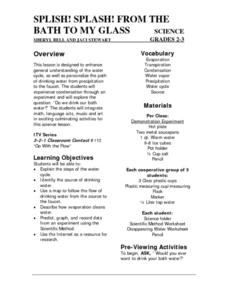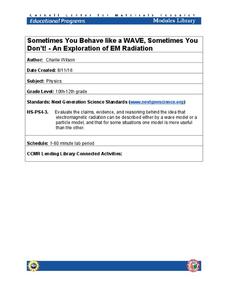Curated OER
Glass Transition in a Rubber Ball
Students illustrate the changes in the properties of a material at its glass transition point. They gather data which they use to construct graphs regarding elastic modules versus absorption modulus, tangent delta, and the effect of...
PBS
Women's History: Glass Windows; Glass Ceilings
Discover stories about women's history in beautiful stained glass windows. The second in a three-part series teaches scholars about a famous artistic style of stained glass windows and the influential women that used art to impact...
Orange County Department of Education
The Glass Slipper Shatters
High school freshmen craft their own definition of honesty. They provide an example from their lives and reflect on the outcomes of their honest behavior. They also identify a time when they may have been dishonest in a relationship and...
Curated OER
Mind-Blowing Glass
Students explore and study the life and art of internationally know glass sculptor, Dale Chihuly. They recognize organic forms in her massive body of blown-glass work and create an organic sculpture of their own utilizing her style of...
Curated OER
Get to Know Glass
Students learn about the properties of glass. In this making and molding glass instructional activity, students participate in an experiment where they will learn how glass is created and how it is shaped to create bottles and jars. ...
Curated OER
How do they make glass into different shapes?
Students investigate the process of glass blowing.In this simulation of glass blowing experiments students experiment how glass is formed and why not all glass is the same.
Curated OER
Swirling, Twirling, Glistening Jewels... Glass Art In Words
Students examine the art form of the glass sculpture. After viewing a three dimensional object, they write creatively describing the object through the use of metaphors. They use peer editing to check for grammatical and spelling errors.
Curated OER
Understanding Eyeglasses
Kids wonder about eyeglasses, and why people have to wear eyeglasses. This should shed some light on the subject. Learners develop an understanding about eyelgasses, and also other visual aids, such as magnifying glasses. In fact, they...
Curated OER
Let's Learn About Plants!
Students discover different plants and plant parts by observing their campus. For this plant life lesson, students take a guided walk around their school with a magnifying glass examining everyday plants as well as photographing them....
Curated OER
Filling the Glass (Water, Air, and Fractions)
Students predict which of two glasses is 1/2 full using visual estimation, height measurement, and liquid measurement methods. Mathematical equations to accurately solve the problem are determined and verified.
Curated OER
The Stained Glass Window
Learners use centimeter rulers and the attached worksheet containing a scale drawing of a stained glass window. The actual measurements of the stained glass window are given, and students are asked to find the actual measurement of the...
Curated OER
Splish! Splash! From the Bath to my Glass
An excellent instructional activity on the water cycle! In it, learners should gain a general understanding of the water cycle, along with how water first falls as precipitation, then ends up coming out of our faucets. This instructional...
101 Questions
You Pour, I Choose
Tall and skinny or short and stout, which glass hold the most liquid? Learners analyze dimensions of cylindrical glasses to determine the one holding the greatest amount of liquid. They brainstorm the relevant dimensions before making...
Virginia Department of Education
Graphing Linear Equations
Combine linear equations and a little creativity to produce a work of art. Math scholars create a design as they graph a list of linear equations. Their project results in a stained glass window pattern that they color.
Curated OER
Dale Chihuly
Students examine the characteristics and makeup of glass. In groups, they research the life and work of Dale Chihuly and how he used glass to create his artwork. They answer discussion questions on different pieces of art and share their...
Curated OER
Playground Zoom
Students observe and draw small objects on the playground or in the classroom with and without a magnifying glass. They explore how lenses can affect the way that an object is observed from afar or remotely sensed. Afterwards, they share...
Curated OER
Is It Recyclable?
Students bring to school five items they would normally throw away and five items they would normally recycle. Expert groups are formed to present information on the recycling of glass, metal, plastic, and organics such as paper and...
Curated OER
Inquiring Minds - Can a Human Voice Really Shatter Glass?
Young scholars watch a video of opera singers breaking glass with their voices. In groups they hypothesize how this is possible and create a test to determine whether or not a human voice can actually shatter glass. They finish watching...
Curated OER
Glass Blowing How Do They Make Glass Into Different Shapes?
Students experiment with butter as a supercooled liquid in order to better explain how glass is made into different shapes.
Curated OER
Crystal Study
Diamonds are a girl's best friend! And crystal labs can be a science teacher's best friend because watching crystals develop is fascinating, and it results in such a pretty product! This activity is unique because the crystals are grown...
Curated OER
Close Observation: Coins
Integrate math, science, and speaking/listening with a collaborative hands-on activity. Each group works with a single penny, examining it with the naked eye and recording observations. Repeat using magnifying glasses. Then repeat with a...
American Museum of Natural History
The Amazing Mundo
Rocks and minerals are great on their own, but they also turn into some pretty amazing stuff! An online lesson explains the different types of materials we get from rocks and minerals, including glass, plastic, and coins. An embedded...
San Francisco Symphony
Admirable Armonica Admirers
What do Ben Franklin and Wolfgang Mozart have in common? Find out about the musical invention, the armonica or glassy-chord. Learners will read about how Ben Franklin invented this new instrument and how Wolfgang Mozart came to play it....
Cornell University
Sometimes You Behave Like a WAVE, Sometimes You Don't!
Electromagnetic radiation behaves like both a wave and a particle. Help classes explore this concept through a lab investigation. Young scientists create optical interference patterns on a glass slide using a carbon layer. They analyze...
Other popular searches
- Magnifying Glass
- Glass Menagerie
- Glass +Craft
- The Glass Castle
- Stained Glass
- The Glass Menagerie
- Glass Mosaic
- Glass Working
- Science Magnifying Glass
- Glass Castle
- Glass Cutting
- Fused Glass

























